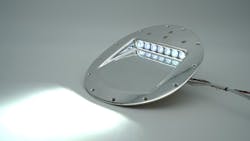How to test and maintain LED lighting
FORT ATKINSON, Wis., - LED external lighting solutions have been embraced to a large extent in both commercial and business aircraft. We have reached out to industry experts to assess how LED exterior lights are tested to evaluate if they are degrading and the repair process for when they are not working, Mario Pierobon reports for AviationPros. Continue reading original article.
The Military & Aerospace Electronics take:
15 September 2023 - LED degradation is mitigated through careful selection of the LED type during the design process, then, during the design and qualification phase of a new LED exterior light product, multiple sample units are tested in extreme environmental conditions beyond those experienced in the flight envelope, explains Heads Up Technologies. “We perform highly accelerated life testing (HALT) to improve product reliability and quality during the product development cycle. HALT identifies product design and manufacturing related failure mechanisms by exposing the product to ever increasing environmental conditions - e.g., temperature, vibration, electromagnetic interference,” says Heads Up Technologies. “If the product fails during HALT, weaknesses are identified, root causes determined, and corrective action implemented, resulting in improved reliability and quality of the LED light. When a light is not working in the field, a simple remove and replace activity can be performed. The unit in question can often be repaired by the manufacturer to reduce the cost impact of failures,”
LED exterior lights undergo various tests to assess their degradation over time and there are some common methods for making this assessment, affirms John Fogel, product manager at Amglo. “The first is the lumen maintenance testing that measures the light output (lumens) of the LED over a specified period. The LED is typically operated continuously, and its light output is measured at regular intervals. By comparing the initial light output to the output after a certain period, the rate of lumen depreciation can be determined,” he says. “LEDs are also sensitive to temperature, and excessive heat can accelerate degradation. Temperature testing involves subjecting the LED to different temperature conditions, both high and low, to assess its performance and degradation, the extreme temperature cycles can help simulate real-world operating conditions and assess the LED’s durability.”
Related: When to upgrade to aircraft LEDs
Related: FAA aims to evaluate utilizing small unmanned aircraft for facility maintenance
Jamie Whitney, Senior Editor
Military + Aerospace Electronics
